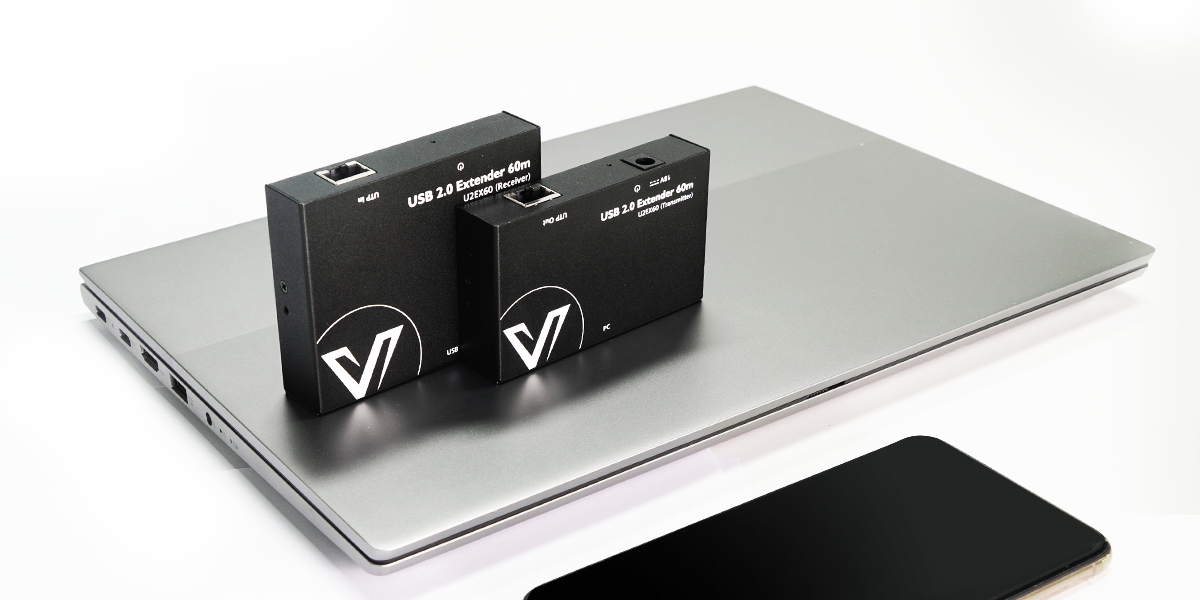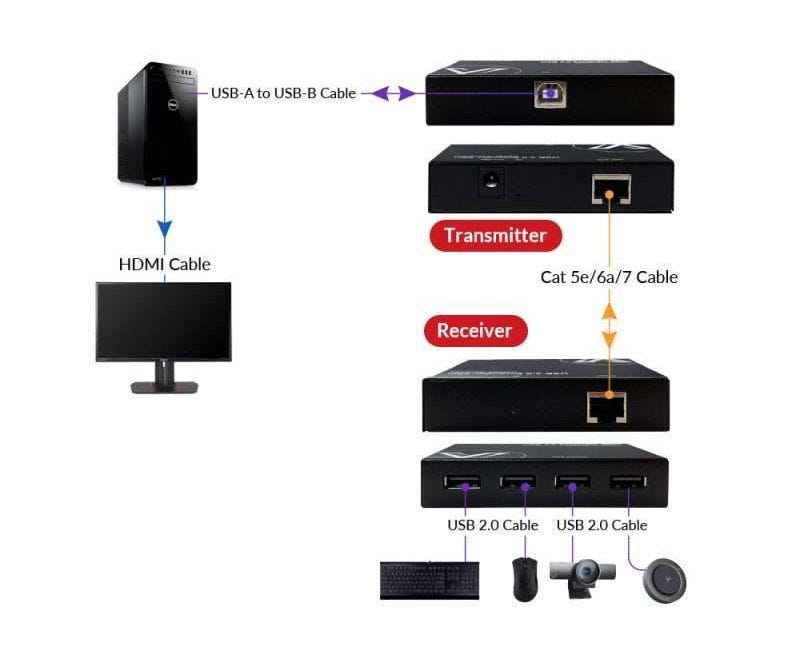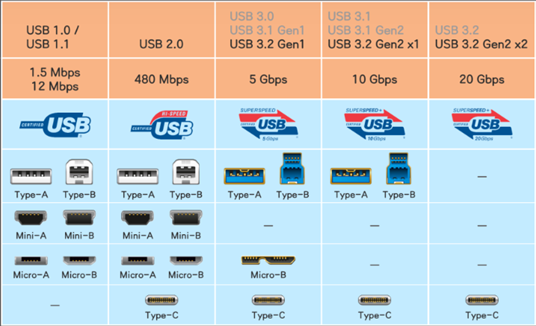
Table of Contents
- Overview of USB Extender
- Development of USB Extender
- Origin of USB Technology
- Passive USB Extension Cables
- Recommended Passive USB Extension Cables
- Active USB Extension Cables
- USB Extenders
- AV Access USB Extenders
- Selecting USB Extenders
- Selection Based on USB Interface Types
- Selection Based on USB Transmission Distance
- Selection Based on USB Transmission Speed
- Development Trends of USB Extender
- Transition to Wireless Transmission
- Transition to Fiber Optic Transmission
- More Resources
Overview of USB Extender
A USB extender is a type of transmission device that extends USB data signals from the local end to a remote end (destination end). It consists of a pair of devices: a transmitter and a receiver. These devices utilize a single network cable to transmit USB data signals, commonly including Cat5, Cat5E, Cat6, Cat6A, and Cat7. For the purpose of extending USB data signals over longer distances, USB extenders amplify and reconstruct the USB data signals to ensure transmission quality and stability.
Typical applications of USB extenders involve connecting USB host devices to the transmitter, which is then connected to a network cable. The network cable carries the USB data signals to the receiver, which, in turn, connects to USB devices on the remote end.

Development of USB Extender
Origin of USB Technology
With the advancement and development of technology, and the overarching trend of high digitization, there has been a pressing need for interconnection and interoperability among various devices. In 1994, Intel, in collaboration with companies like IBM, Compaq, Microsoft, NEC, DEC, and others, jointly introduced the USB (Universal Serial Bus) transmission protocol. In 1995, they established the USB Implementers Forum (USB-IF), which is the current standardization organization for USB. Its primary goal is to drive the development and application of USB, enabling various devices to have better interoperability and compatibility through USB interfaces.
Passive USB Extension Cables
Different USB interface standards and protocols have varying requirements for data transmission rates and power consumption. As the length of USB cables increases, USB communication can suffer from signal attenuation, making it more susceptible to interference and data loss. Consequently, each type of USB cable has limitations on its maximum transmission distance. Passive USB extension cables ensure USB signal transmission distance and quality by improving the material, diameter, and connector craftsmanship of the cable itself.
Recommended Passive USB Extension Cables
- For USB 1.1 (Full Speed):A cable of 3 meters with an effective bandwidth of 12 Mbps.
- For USB 2.0 (High Speed):A cable of 5 meters with an effective bandwidth of 480 Mbps.
- For USB 3.2 Gen 1:A cable of 2 to 3 meters with an effective bandwidth of 5 Gbps.
Active USB Extension Cables
Due to the increasing complexity of USB device usage scenarios, passive USB extension cables are no longer sufficient to meet the requirements. This led to the development of active USB extension cables. Active USB extension cables enhance signal strength and improve transmission distance and signal quality by incorporating amplifier chips at one or both ends of the cable. They typically support transmission distances ranging from 5 to 30 meters.
USB Extenders
In order to meet the requirements for longer, more stable and reliable USB signal transmission, the market introduced chips with USB signal extension capabilities in 2014. USB extenders with the USB extender chips can achieve transmission distances of 50–100 meters, surpassing USB extender cables in terms of transmission distance and stability.
AV Access USB Extenders
AV Access, as a professional provider of extenders, keeps pace with technological trends and has developed various USB extender products. We have accumulated years of experience in this field, demonstrating a deep understanding of demand analysis and strong technical capabilities. Our products are known for the stability and reliability and can cater to various requirements.
Here are some of our USB extender models based on USB extender chip classification. For more specific product models and features, You can contact us via info@avaccess.com.
USB Extender ModelUSB Interface versionTransmission DistanceTransmission MediumU2EX50USB 2.080 metersCat XU2EX60USB 2.080 metersCat XUSB 3.0 Extender (Coming Soon)USB 3.0100 metersCat & HDBT
Selecting USB Extenders
Selection Based on USB Interface Types
USB interfaces come in various types, such as Type-A, Type-B, and Type-C. When purchasing USB extension cables or devices, it’s essential to choose the appropriate interface type based on the usage scenario and device type.
Selection Based on USB Transmission Distance
When selecting USB extension cables or devices, consider the actual distance between two devices in your usage scenario. If the extension distance is under 5 meters, passive USB extension cables are suitable. If the extension distance is between 5 to 30 meters, you can choose active USB extender cables or USB extenders. For distances between 30 to 100 meters, USB extenders are an option, but be aware that different USB extenders may have varying transmission performance.
Selection Based on USB Transmission Speed
In the USB 2.0 standard, the maximum transmission speed of USB interfaces is 480 Mbps, while in the USB 3.0 standard, it’s 5 Gbps. When purchasing USB extension cables or devices, select based on the required transmission speed in your actual usage scenario.

Development Trends of USB Extender
Transition to Wireless Transmission
Complex cabling during project construction can increase construction difficulties, troubleshooting challenges, and even impact aesthetics at the site. Therefore, there is a growing demand among professionals for wireless connections.
Transition to Fiber Optic Transmission
In certain special projects, customers may have requirements for extended transmission distances. Typically, fiber optic extender equipment is used to meet these demands.
AV Access possesses technology for wireless USB extension and fiber optic USB extension. That’s all for the article. If you have any questions or inquiries, please feel free to email us via info@avaccess.com.
More Resources
You may also be interested in other blogs:

No comments yet